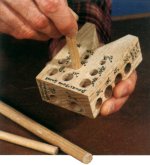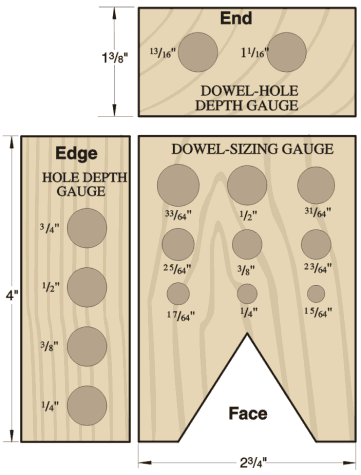Dowel Gauge
 Doweling
can turn dicey when the dowels don't quite measure up to their stated
diameter—or the hole you drill is too shallow or too deep. The solution? Build
our 4-in-1 dowel gauge. With it you can double-check these measurements before
you assemble a project.
Doweling
can turn dicey when the dowels don't quite measure up to their stated
diameter—or the hole you drill is too shallow or too deep. The solution? Build
our 4-in-1 dowel gauge. With it you can double-check these measurements before
you assemble a project.
Here are the four features this handy helper provides:
1. The dowel-sizing gauge on the face of the block offers three holes
with standard dowel diameters plus holes that measure 1/64" larger and smaller
than the standard diameters. Check the fit of your dowels in these holes, then
you can select the appropriate drill bit if your dowel is just a hair too big or
too little.
2. When you want to drill a hole to a precise depth, use the
hole-depth gauge. Just insert your drill bit in the appropriate hole, and mark
the depth on the shank of the bit with a piece of tape.
3. The dowel-hole depth gauge gives you two holes that measure
one-half the length of two standard dowel lengths—1-1/2" and 2"—plus 1/16". Use
these holes to mark the depth on your drill bit. By drilling your dowel holes
1/16" deeper, you give excess glue a place to escape and your dowel won't
protrude too far from its hole.
4. At the rear of the block, the V-slot helps keep your drill bit
plumb. Just place the bit on the workpiece, push the slot up to the bit, and
tilt the bit until it fits snugly in the corner of the slot.
To build the gauge, use a piece of kiln-dried hardwood. This will help
minimize any humidity-related swelling and shrinking of the wood.

 Doweling
can turn dicey when the dowels don't quite measure up to their stated
diameter—or the hole you drill is too shallow or too deep. The solution? Build
our 4-in-1 dowel gauge. With it you can double-check these measurements before
you assemble a project.
Doweling
can turn dicey when the dowels don't quite measure up to their stated
diameter—or the hole you drill is too shallow or too deep. The solution? Build
our 4-in-1 dowel gauge. With it you can double-check these measurements before
you assemble a project. 